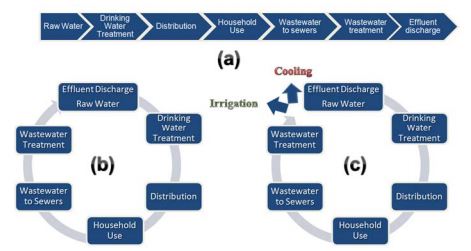Last week, our research group participated in this year’s Imperial Fringe, a series of public events exploring the unexpected side of science. The event is based on Imperial’s ground-breaking research, and is comprised of public evening events to engage with and build Festival audiences throughout the year via innovative public programming.
We took this opportunity to demonstrate one of the key areas of our research: water reuse or recycling. Our group decided to promote awareness by having attendees of Imperial Fringe to taste the difference and to see if they can discern between the three water types: tap water, bottled water and reclaimed/recycled water.
To give you more information, reclaimed water is former wastewater (sewage) that is treated to remove solids and impurities, and used in sustainable landscaping irrigation, to recharge groundwater aquifers, to meet commercial and industrial water needs, and for drinking. The use of reclaimed water is very controversial especially if used for potable uses, I mean no one really wants to know that the water they are drinking comes from what you flushed down the toilet, right?

However, water reclamation and reuse provides a unique and viable opportunity to augment traditional water supplies. By reusing water a number of benefits can be achieved, including (from Voulvoulis, 2015):
- Contribution to alleviating water scarcity problems
- Pollution prevention through decreased effluent discharge
- Water conservation from the reduced need to extract and treat freshwater, reduced energy costs from the separate treatment of freshwater and wastewater,
- A business opportunity from exporting the recovered water to other end uses (agricultural and landscape irrigation, cooling water for power plants and oil refineries, other industrial uses, drinking water, boiler make-up water, etc.)
- Enhanced self-sufficiency for water
- Reduction of wastewater discharge costs
- Elimination of business risks related to water availability and possible future regulatory changes on wastewater discharge and management (that could entail additional costs),
- ‘Greening’ of the business and increasing its brand value
Of course, there are barriers to the use of reclaimed water. One of which is public perception: the intensity of the public’s reaction, concern, and debate over water reuse is magnified when the reuse issues change from non-potable to potable. Therefore, one must promote communication and dialogue between the water managers and the public, ensure that information is accessible to those who want to know more and most importantly, build and maintain public trust (Hartley, 2006). Another limiting factor for water reuse can in many circumstances be the quality of the water available linked to the treatment processes (technical options) and potential hazards for secondary users. Examples of technologies that deliver the highest grade water for reuse are ultra filtration, reverse osmosis and ultraviolet disinfection (often in combination), which are very costly. In any case, its economic viability needs a careful cost-benefit analysis for the various parties involved to be carried out (Voulvoulis, 2015).
We hope that you enjoyed this post. Stay tuned for more research updates!
References
Hartley, T.W. 2006. Public perception and participation in water reuse. Desalination, 187, 115-126.
Voulvoulis, N. 2015. The potential of water reuse as a management option for water security under the ecosystem services approach . Desalination and Water Treatment, 3263-3271.



